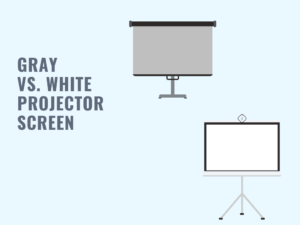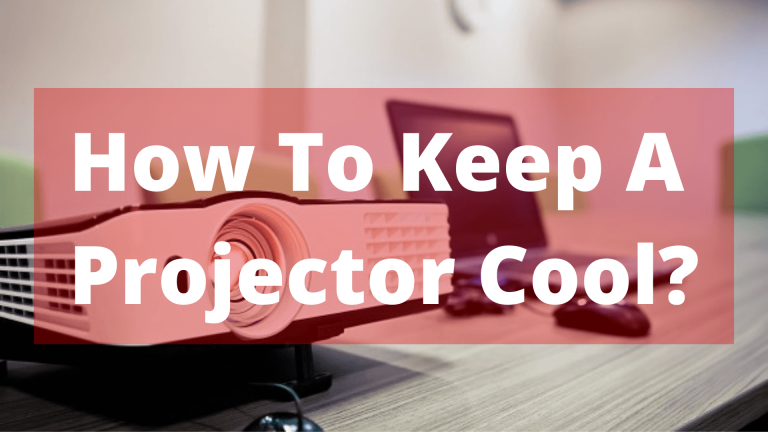Which Color Projector Screen Is Best?
A good projector screen reflects projected light in a way that makes it easier to see in bright environments. When used correctly, a projector screen can turn any home or office into an impressive movie theater or multimedia presentation room!
Which Color Projector Screen Is Best? When it comes to projecting images in a darkened room, a white screen will always appear brighter than an equivalent gray screen. This is because the white screen reflects more ambient light than the gray screen. This is because a white object’s surface reflects more light than any other color.
This is why many computer monitors and televisions are made with a white background. Since a gray screen absorbs more light, it will appear darker than a white screen.
This becomes especially important if you want to project an image without disturbing others in the room. If you’re looking for an ideal image screening solution, consider investing in a projector with a gray or black background instead of a white one.
Does Projector Screen Make A Difference?

A good screen provides a smooth, color-neutral surface that helps preserve your projector’s brightness and overall image quality. Using a screen can decrease the projector’s brightness as light is scattered and refracted by the screen. However, this is only sometimes the case. Many experts agree that using a screen will have a minor impact on your projector’s brightness or image quality, though it may improve both.
Does the Projector Screen Have To Be White?
Most people who own a projector screen assume it needs to be white to produce a clear image. However, this is only sometimes the case.
Projector screens can be made of different colors, including black and gray. This is especially useful if you want to use your projector for presentations in a room with other brightly-coloured objects, such as paintings or wallpaper.
If you’re using your projector for entertainment purposes only, then going with a white screen will give you the best results. However, if you plan on using your projector for professional purposes (such as creating flyers or business cards), then using a screen that’s not completely white will give your audience the impression that you’re more dedicated to your work than they are.
Black Vs White Projector Screen

Black projector screens are better than white and gray screens regarding image quality. This is because black screens don’t reflect light as much as white and gray screens, which results in a more accurate picture. Additionally, black screens are less likely to be affected by ambient light, making them the perfect choice for presentations or movies that need to be viewed in a dark room.
Pros and Cons Of White Screen
Gray Vs White Projector Screen

Grey projector screens are known as high-contrast screens designed to absorb ambient light. White projector screens reflect light and make it difficult to see the image.
There are two types of projectors- white and gray. Gray projectors were designed to be used in high-contrast environments, such as movie theaters or lecture halls. White projectors are more common in homes and offices because they are more reliable in bright light.
The difference between the two types of projectors is how they reflect light. Gray projectors use a lot of black material to contrast with the surrounding environment, making it harder for ambient light to shine through and disturb the image on the screen. White projectors use a lot of white material, which makes it easier for ambient light to bounce off and disturb the image on the screen.
Pros And Cons Of Gray Projector Screen
Pros And Cons Of White Projector Screen
Projector Screen Vs White Wall

A special coating is applied to projector screens to make them more reflective. This coating is not typically found on walls, which projects onto the screen with a brighter image.
Projector screens can also be used in business settings where there is a need for a bright image. A white wall will not have this special coating and, as a result, will cast darker shadows on videos or presentations being shown.
Pros And Cons Of Projector Screen
Pros And Cons Of White Wall
Frequently Asked Question
What is the best material for a projector screen?
Projectors are a popular tool in homes and businesses, but they can be a hassle to use if the screen is not properly illuminated. A common solution is to use a white sheet or curtain as a background for the projector, but these materials can often be difficult to keep clean and free from wrinkles.
One possible alternative is to use white blackout cloth. This material is specifically designed to block out light, and it can be easily cleaned with a damp cloth. Since it doesn’t reflect light like other materials, blackout cloth is ideal for a projector screen because it doesn’t distract from the image displayed on the screen.
What color background is best for a projector?
Since the advent of projectors, people have asked what the best color for a projector screen background is. Some people believe that a dark gray or black background will give a more accurate image, while others feel that a lighter color can be more pleasing to the eye. Ultimately, it is up to the projector owner to decide what color they would like in their background.
How many types of projection screen are there?
There are two main styles or core designs of screens: fixed and retractable. Each has its own set of advantages and disadvantages.
- Fixed screens are typically used in large, open spaces where visibility is essential. They are usually the most expensive and complex to install, but they can be very versatile. They typically use a projector to project images onto a surface, such as a wall or a screen.
- Retractable screens are typically used in more confined spaces, such as meeting rooms or small theaters. They are much cheaper to install than fixed screens and require no projector. Images are instead displayed on a flat panel that is pulled back behind the screen when not in use.
Conclusion:
The best color projector screen is the one that best fits your needs and preferences. The screen’s size, brightness, and resolution all play a role in determining its quality. If you’re starting out with projector technology, buying an inexpensive screen may be your best decision. However, if you’re looking to upgrade your current projector or are already familiar with its features, investing in a higher-quality screen is likely the better option.







